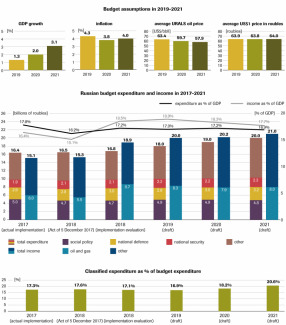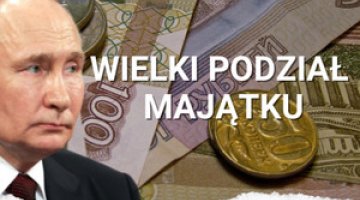Russia’s budget for 2019–2021: increasing reserves, decreasing transparency
Russia’s draft budget for 2019–2021 was accepted on 21 November by the State Duma and, on 23 November, by the Federation Council. The document is still to be signed by the president. The draft budget for 2019 was based on the following assumptions: GDP will grow by 1.3% (so more slowly than the 1.8% forecast in 2018); inflation will be 4.3%; the average price of Urals oil barrel will be US$63.4/bbl (as compared to the approximately US$70/bbl estimated in 2018); and the average dollar exchange rate will be 63.9 roubles (key assumptions and parameters of the budget for 2019–2021, see Appendix).
It is the first time since 2014 that Russia’s budget has been planned with a surplus. The rule that only income generated by the oil and gas sector based on the oil price of US$40/bbl can be allocated for budget expenses will continue to apply in the coming years. A surplus achieved in the case of higher oil prices will replenish the reserves of the National Welfare Fund. Its reserves are expected to grow to almost 13% of GDP by the end of 2021 (as compared to 3.8% of GDP in 2018). Regardless of this, a nominal increase in spending is planned mainly owing to growing incomes from sources other than the oil and gas sector, for example, as a result of a VAT increase. When compared to 2018, nominal spending on national security is expected to grow by 10% in 2021, and on national defence by 5.5%, while spending on social policy is planned to remain on almost the same level. Nearly 10% of all budget spending has been allocated to implementing the national priorities set by President Putin in a decree passed in May this year aimed at improving social standards and rapid economic development by 2024.
Commentary
- It can be concluded on the grounds of the draft budget that the government is trying to make savings on what has been one of the key budget priorities: social policy. This is so because the government is focused on increasing reserves in case of a downward trend on the international markets. In effect, the share of spending on social policy in budget expenses as a whole is planned to be reduced from 30% in 2017 to 23.5% in 2021. It is worth noting that the planned spending on the pension fund in the coming years in principle will not be reduced. The cost cuts achieved through raising the retirement age starting from 2019 will be almost entirely neutralised by increasing expenditure on pensions.
- Regardless of the relatively high spending in priority areas, it will be very difficult to achieve the goals set by the president (this especially concerns investment in human resources). This is so because there are as many as thirteen priority programmes, and the increase in the total value of budget expenditure is rather moderate.
- The level of transparency of the Russian budget will fall in the coming years due to the increase of the share of classified spending to 20% of the total in 2021 (from around 17% in 2017). Scrutiny of these expenses is rather limited, which creates room for corruption. The increase in classified budget spending has been underway since 2009 (when they were at a level of 10%). It is also worth remembering that increasing expenditure on selected purposes during the implementation of the budget is a well-established practice.
APPENDIX






